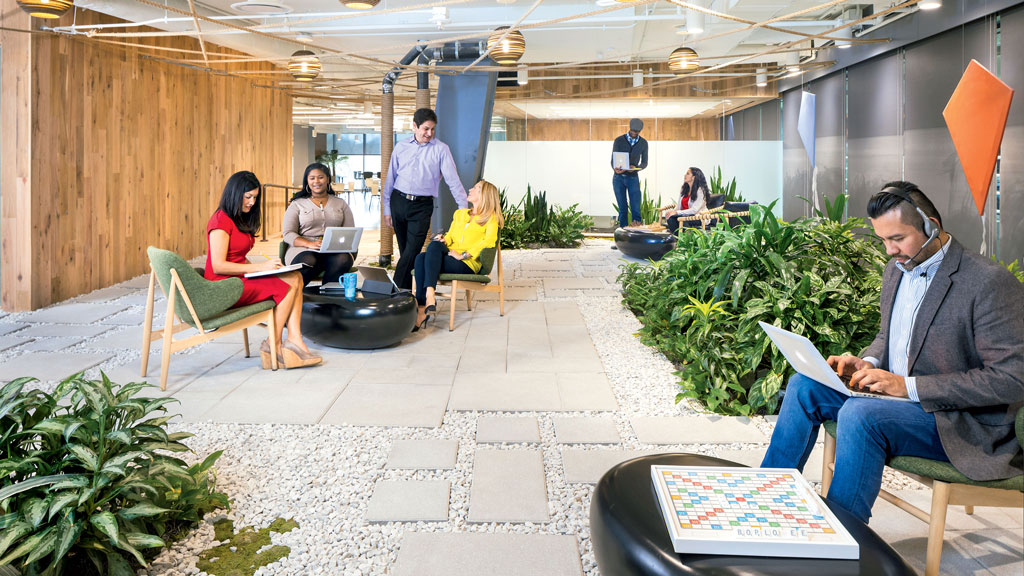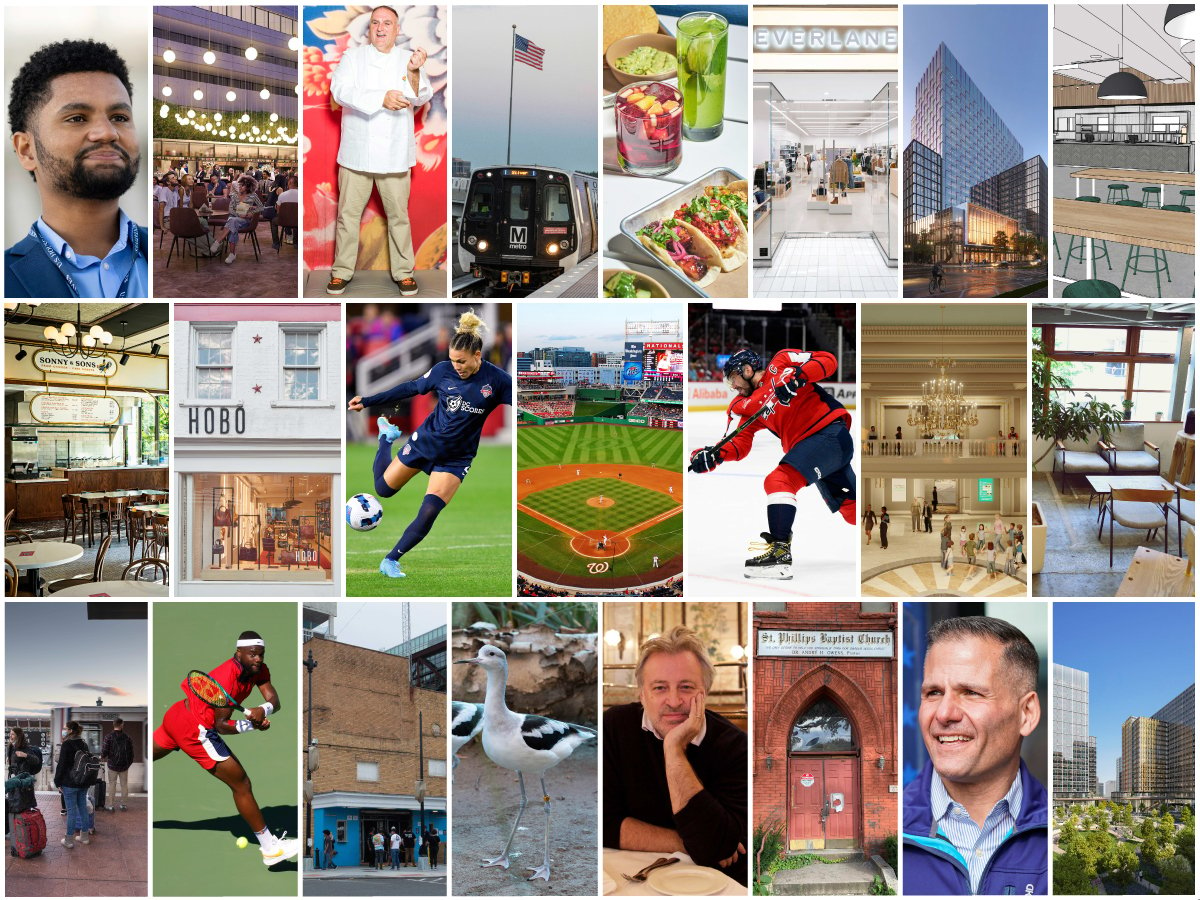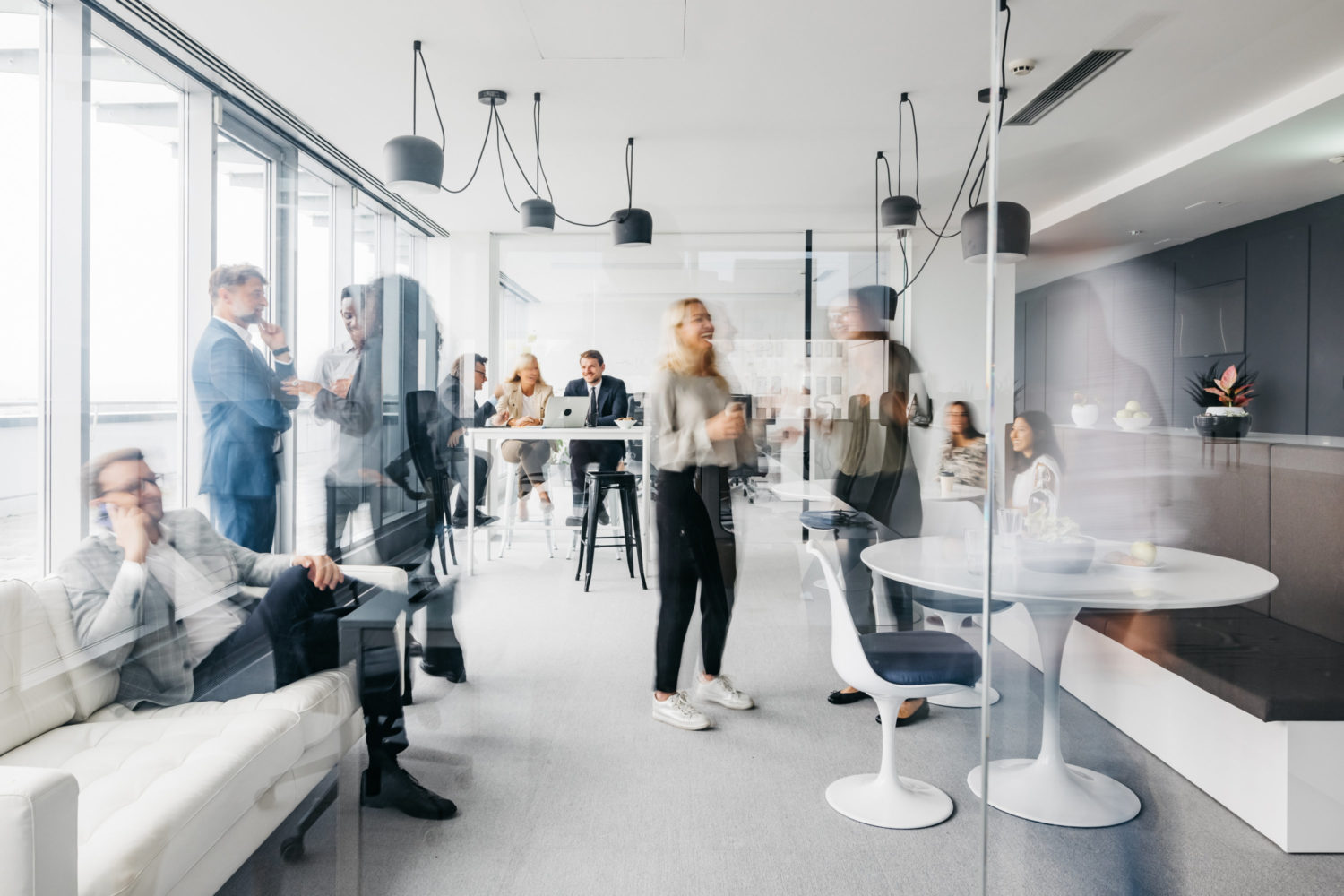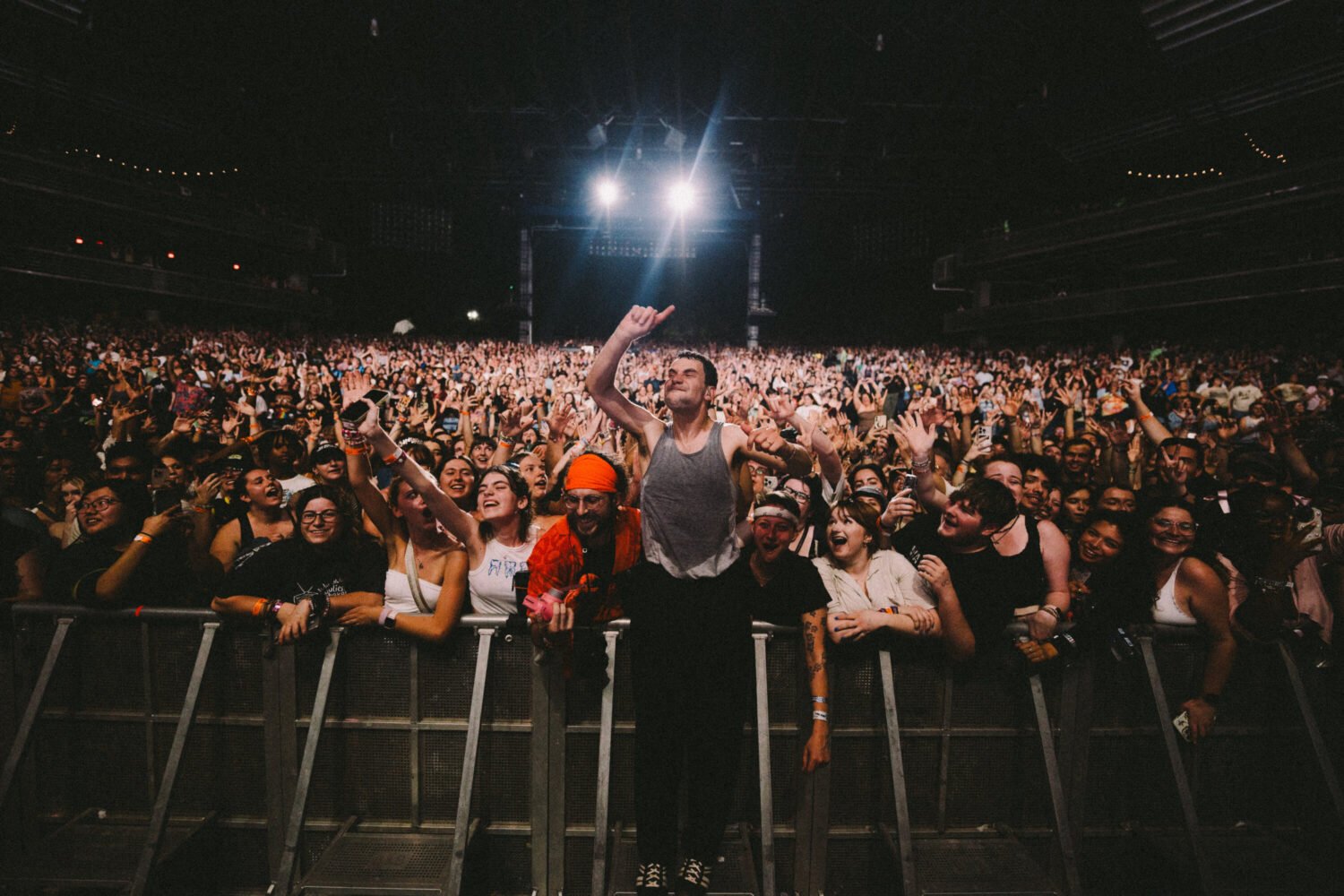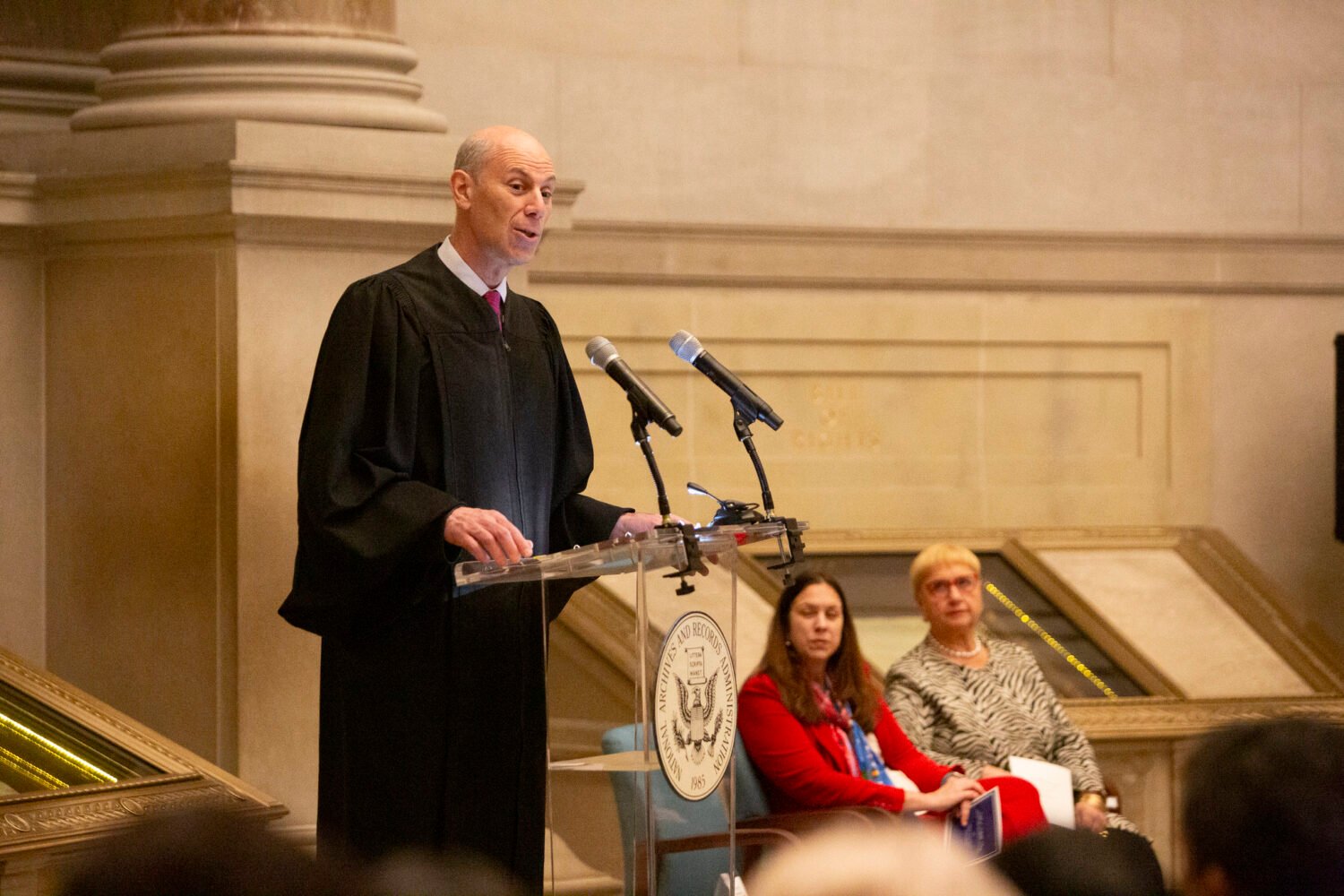The first thing you notice is the snacks.
Step off the elevator at Bloomberg’s DC office and there’s a pantry brimming with free Terra chips, Kind bars, Oreos, hard-boiled eggs, bagels, and other bites.
Like so many Washington offices built or renovated in the past decade, the suite features lots of natural light and homey touches such as sofas and fish tanks. While there are glass-walled spaces for privacy, no one gets a private office. Instead, everybody has a sit/stand desk in the open. Some desks sit empty, as people work remotely or from home.
This is how many of us now work—or may, soon enough.
“We are in the midst of a fairly profound paradigm as far as the nature of offices and how we work, and Washington is on the leading edge of that,” says Mark Ramirez of Hickok Cole Architects.
Here’s what’s new—and next—in Washington offices.
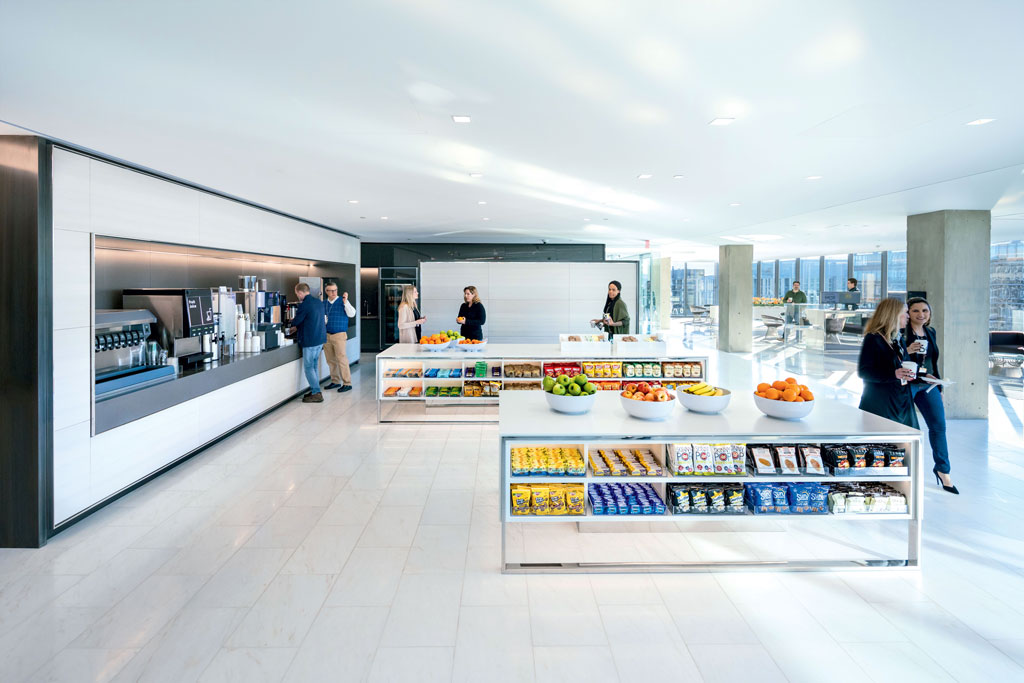
Private workspaces won’t go away, but you won’t necessarily have your own office.
In recent years, many businesses hoping to spark the same innovation and nimbleness as Facebook and Google tore down walls and introduced open floor plans. Even a government agency, the General Services Administration, modernized its offices, making 95 percent of its space open.
Real-estate costs were often a factor, too: According to office-furniture maker Herman Miller, workstations sit empty 60 percent of the time, private offices 80 percent. With technology allowing more employees to work from anywhere, companies could save square-footage by going to open, flexible work sites where workers got less territory.
Results were not always good.
Yes, studies found that open offices were more collaborative, that they could lead to serendipitous exchanges of ideas, and that communication got easier and quicker, which can be key in fast-paced industries. But other research showed that morale dipped, sick days and stress rose, and productivity dropped. One study found that every time we’re interrupted, it takes an average of 23 minutes to regain focus on a task.
Open spaces didn’t make sense for all organizations. Some put walls back up. Some threw red flags up—literally.
At AARP, which is removing some walls in its DC headquarters, employees who worried about the distraction of open workstations came up with a system—they can display a green, yellow, or red flag to signal how willing they are to be disturbed.
Ripping out walls alone doesn’t create collaboration, just as putting in a foosball table won’t. It can take five to seven years to change workplace culture, and that change has to come from the top, says Craig Simpson, president of ORTalent, a firm in Tysons that helps companies build leaders.
“All of our clients say, ‘We want to be more innovative,’ ” Simpson says. “Take down the walls, by all means, but also allow people to make mistakes. And don’t tell them what to do, but coach them on how to do it.”
There has been such pushback against totally open floor plans that architects and companies doing renovations now espouse a mix of private and open. A company may keep private offices but change the walls to glass. Firms with open layouts are constructing more places where employees can think or talk—not just lounges and cafes but “huddle rooms” and “phone booths.” (Because managers need somewhere in an open office to fire employees, sometimes one space becomes a de facto “crying room.”)
“When there’s nowhere to talk in private, people end up having shallower conversations,” says Ron Friedman, a psychologist and the author of The Best Place to Work: The Art and Science of Creating an Extraordinary Workplace. “Unless we are giving people an option to work in private when they need to, we are not going to succeed.”
“Alone together” is increasingly how we’ll work.
When the nonprofit Data Quality Campaign was designing its new office space before a recent move, management toured many open offices. “The thing that struck us,” says executive vice president Paige Kowalski, “is you have everyone sitting there with headphones on—and not only are people not talking to one another, but it feels more intrusive to interrupt them.”
When their staff of 22—most of whom are millennials—said they’d rather have private offices, DQC erected walls. It also put in spaces for colleagues to congregate. “For example, the kitchen,” Kowalski says. “Everyone ends up in the kitchen. We designed several spaces to facilitate natural collaboration, as opposed to knocking down walls, which is sort of a forced collaboration.”
If an open office is designed to stimulate energy and collaboration, don’t employees wearing earbuds thwart that?
No, says Todd Heiser, a design director at the architecture firm Gensler. Earbuds, he says, are part of the “alone together” trend, visible at any Starbucks: “We like to be alone and focused on our work, but we also like to be part of a larger community. We have noise-canceling headphones where we can create focus, yet like to be around buzz. That’s why this is happening.”
While people of all ages crave a sense of belonging, the urge to find community at work seems strongest among millennials—who will make up nearly half of the workforce by 2020 and whom companies are eager to attract.
Previous generations made friends at the office, of course, but for a generation raised with Facebook and text messaging, the place we spend so much of our day—face to face with people—now often provides the most human interaction we get.
Although personal interaction fosters the strongest connections, tools such as Slack, Skype, and iPad “robots” on wheels—which allow someone off-site to be at a meeting—can keep a team engaged when they’re not together every day. Companies are hiring employees, with such titles as “chief experience officer,” to plan team-building events. Coworkers play laser tag, make sandwiches for charity, attend Nats games, hit happy hours. It’s not just at happy hours, though, that coworkers are lifting a glass together—many workplaces now offer free beer and wine, sometimes on draft or in kegs, all day long.
“The more we can work from anywhere, the more we come to the office for key needs we can’t get anywhere else. That social aspect is critical,” says Tracy Brower, author of Bring Work to Life by Bringing Life to Work: A Guide for Leaders and Organizations. “When companies meet that need, they’re more likely to have people stay around.”
Offices are becoming more like high-end apartment buildings.
Just as high-end condo complexes now sport rooftop pools and dog-washing stations, office buildings are installing spa-like fitness centers and bike-repair stations. When it’s so easy to work from home, after all, employers may need to offer more incentives to make the commute.
“It’s going to be nicer to come into an office when the amenities are nicer than your kitchen table or the neighborhood Starbucks,” says Jill Goebel, a design director at Gensler.
WeWork, a coworking space with locations in Tysons and Dupont Circle, offers clients free beer and cold-brew coffee on tap. The Crystal City start-up incubator 1776 hired chef Aaron Butler from the Red Hen, a restaurant in Bloomingdale, to cook up lunch fare such as Tuscan pork ribs and lamb sausage.
“It used to be you went to work and then you went home,” says Merrell Ashley of Rand Construction. “Now you’re connected all the time, so you don’t really ever stop working. Going to work and being at home is starting to blend together, so what the market is trying to do is make the office a comfortable place that blends home and work.”
People are more creative when exposed to nature, so at AARP some walls are covered in moss. Teaching Strategies, a developer of resources for early-childhood educators, has an indoor garden. At the law firm Hogan Lovells, a rooftop with views of the Lincoln and Jefferson memorials and the Washington Monument is outfitted with wi-fi and lounge seating. The law firm Sidley Austin—like Hogan Lovells and Teaching Strategies, an office done by Gensler—installed a fireplace in its cafe. A recent renovation at Carfax in Centreville added a sculpture garden, outdoor Ping-Pong, and a fire pit, plus an indoor “park” with green shag carpeting, swings, picnic tables, and a putting green. “There’s a different kind of conversation that might happen when you’re practicing your short game,” says Larry Gamache, Carfax’s communications director. “We want our team to have conversations that move our business forward but also replenish their spirit.”
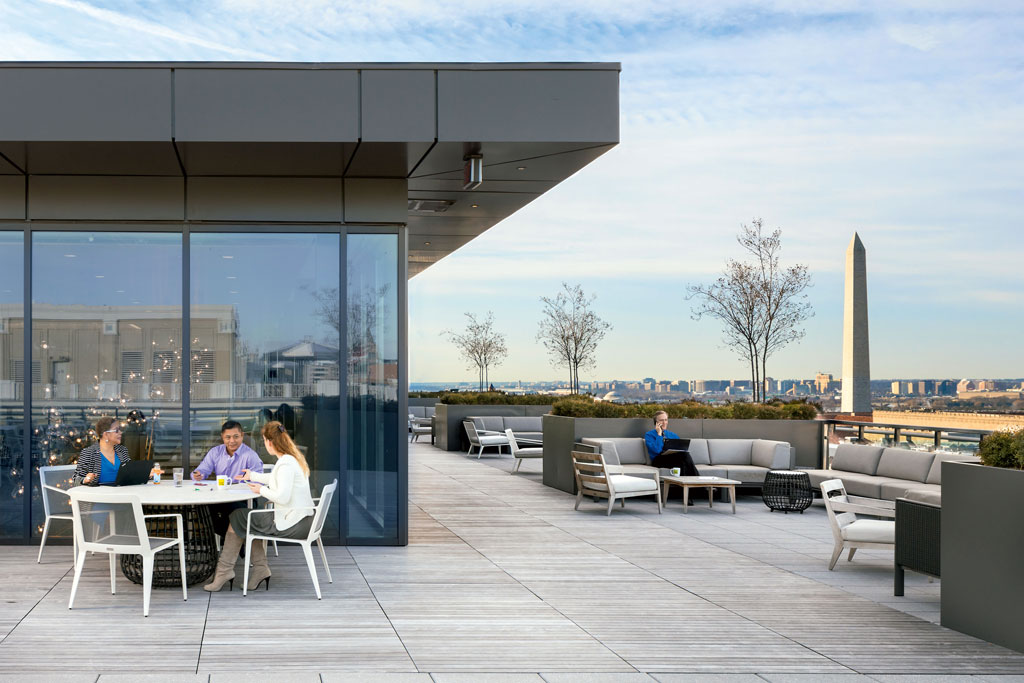
Gamache says the indoor park and putting green aren’t designed to make people give up telecommuting: “Even as we do this, we are investing in technology to make it easier to work from home and to connect people who work remotely. It matters less to us where you’re working and more that you and your team are working effectively.”
That’s not the case everywhere, says David Ballard, who heads the American Psychological Association’s Center for Organizational Excellence: “There has been an increase in flexible work, but what hasn’t kept pace is how we’re managing people. We’re measuring people by the fact they’re not sitting at their desk.”
If supervisors aren’t taking breaks on the roof or at the fire pit, employees won’t, either—for fear they’ll look like slackers. “I’ve worked with companies that put in a coffee bar but no one is in the coffee bar,” Brower says. “The culture has to be about meeting objectives and not time in your seat.”
Forget the corner office. The new status symbol is the latest laptop or a flex schedule.
For generations of employees, the ultimate symbol that they’d arrived was moving into their own office. Over time, bosses adopted “open door” policies to signal approachability. But employees don’t always feel that a door is truly open. Tearing down walls, the thinking goes, eliminates barriers to managers, leading to quicker feedback and decisions.
Still, says Anne Marie Kilgallon, AARP’s vice president of enterprise strategy and innovation—and a Gen-Xer: “For the older generation, when you have that office and you lose it, you feel like you’ve lost everything. Sometimes people put so much weight on physical space. I think earning the trust to head a big project means more to me than a larger office.”
Besides, says Brower, “millennials are much more into defining status by the technology they get. Give them a great laptop and they’ll work anywhere.”
That’s what many companies are doing. Status might be conferred now with the latest gadgets, a more flexible schedule, a chance to learn new skills, or the opportunity to do a project a worker is passionate about.
“Boomers were all about climbing the corporate ladder,” Simpson says. “A lot of the new generation want meaningful work.”
Ripping down walls is a symbol of a new “we’re all in this together” mentality. In some firms, that’s all it is.
“Where we get into trouble is when we think we got rid of corner offices, so we got rid of status and hierarchy,” Friedman says.
Younger generations raised with an emphasis on “team work” prefer collaborative versus top-down decision-making. Firms aiming to be less hierarchical might flatten the chain of command. At Tiber Solutions, an IT firm in Fairfax, all employees except the CEO and chief technology officer are on the same tier. That can make an organization nimble—and a magnet for millennials, says Brower: “Millennials are impatient about growing their career. One of the things they look for is to what extent they can rub elbows with leaders.”
Ironically, that kind of organizational structure comes with a cost: With fewer rungs on the corporate ladder, there are fewer chances for an employee to get ahead.
Your company will watch over your physical and mental health, your relationships, and your finances.
At Suntiva, a management-consulting firm in Falls Church, all employees are issued Fitbits so they can track their daily steps and calories burned. Colleagues sign up for competitions, such as one that challenged teams of six or seven to walk an average of 6,000 steps a day for seven weeks to approximate the distance to California and back.
“There’s a greater focus on employee well-being,” Ballard says. “It started as a way to reduce health-care costs. Over time, that shifted to not only physical health but also an employee’s mental health, interpersonal relationships, relationships to the community, even financial well-being. It’s looking at employees as a whole person and helping employees be their best, which in turn impacts job performance.”
Bridgewater Wealth & Financial Management in Bethesda offers guided meditation every afternoon. Decisive Analytics Corporation in Arlington ponies up for free financial planning. Vox made some of its restrooms gender-neutral. Apex Home Loans in Rockville sponsors more than 30 volunteer events a year for employees to join.
And everywhere, demand has surged for sit/stand desks. Their sales at Herman Miller have risen by 250 percent in the past three years.
Yet if employees don’t see something as a benefit to them, the effort can fail.
“There’s a resurgence of paternalism in the workplace,” Ballard says. “For example, some employers are saying, ‘We don’t want work to spill over into people’s lives,’ and their solution is ‘We’re going to shut off e-mail from 7 pm to 7 am.’ Their intentions are good, but what they wind up doing is imposing what they think is the best solution. We know that to reduce stress and improve performance, employees need to have control over how they do the work.”
A better model, says Friedman: Some companies pay a bonus to employees who don’t check e-mail while on vacation.
Are free, healthy snacks a generous perk or crossing into a nanny state? Are they a ruse to keep employees at their desks? Whatever the employer motivation, employees say the gesture makes them feel that their bosses care.
“Feeling valued in the workplace is huge,” says Ballard. “There are huge differences between those who feel valued and those who don’t, in terms of job turnover, job performance, and job satisfaction.”
This article appears in the March 2017 issue of Washingtonian.

